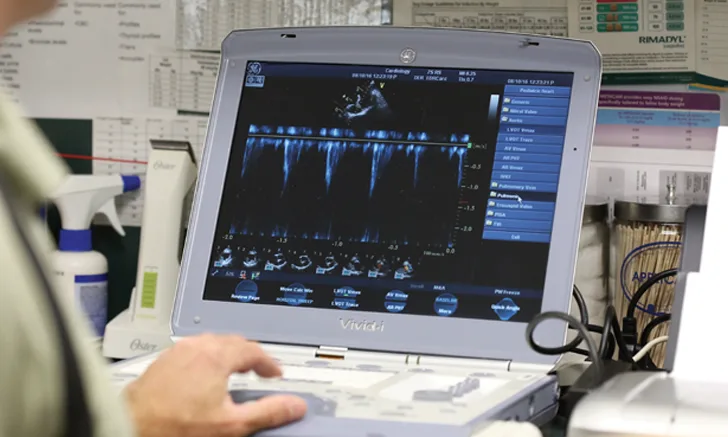Clinical Applications of Clopidogrel in Dogs & Cats
Brian A. Scansen, DVM, MS, DACVIM (Cardiology), Colorado State University

Clopidogrel, an oral antiplatelet medication in the thienopyridine drug class, is indicated in cats with or at risk for intracardiac thrombi development. It is also used in dogs with active thromboembolic disease or other prothrombic conditions.
Clinical Applications of Clopidogrel
Clopidogrel is indicated in animals with documented thrombosis to limit further platelet aggregation and thrombi expansion.
In cats, thrombi are most often observed on echocardiographic evaluation of the left auricular appendage or in the distal aorta following cardiogenic embolism.1
In dogs, arterial thrombosis has been associated with renal disease, corticosteroid administration, neoplasia, and heart disease.2 Portal venous thrombosis has been associated with hepatic disease, neoplasia, immune and infectious diseases, and corticosteroid administration.3
Clopidogrel is often administered to dogs and cats with a perceived increased risk for thrombosis, although few studies have evaluated the efficacy of this approach.4,5
In cats, a total dose of 18.75 mg (one-quarter of a 75-mg tablet) PO once a day has been shown to reduce platelet aggregation and prolong oral mucosal bleeding time.6
This dose should be administered clinically to cats, regardless of body weight.
A prospective clinical trial comparing use of clopidogrel with use of aspirin in cats previously affected by arterial thromboembolism (ATE) showed a longer time to recurrent ATE in cats receiving clopidogrel (443 days) vs aspirin (192 days).4
Clopidogrel is therefore recommended as thromboembolic protection in cats found to be at risk for ATE.
In dogs, 1-2 mg/kg PO once a day for 3 days resulted in maximal platelet inhibition.7
Alternatively, an oral loading dose of 10 mg/kg provided maximal platelet inhibition within 90 minutes.7
A pilot study of 24 dogs with immune-mediated hemolytic anemia failed to show a difference in 90-day survival when treated with clopidogrel alone (n = 8), aspirin alone (n = 8), or a combination of the two (n = 8).5
Combined administration of clopidogrel and aspirin can be used for dual antiplatelet inhibition, as each agent acts on different platelet receptors.8
However, increased risk for GI side effects have been reported in humans receiving dual therapy and are likely to occur in animals as well.8
Mechanism & Spectrum of Action
As a thienopyridine derivative, clopidogrel irreversibly inhibits the P2Y12 receptor on platelets.9
The ligand for this receptor is adenosine diphosphate (ADP).
When bound, ADP leads to platelet activation and initiates thrombosis.9
The active metabolite of clopidogrel is produced by biotransformation of the prodrug by hepatic cytochrome P450 enzymes.10
Pharmacodynamic differences in clinical efficacy exist in humans (related to genetic variants in cytochrome P450 activity).10
As preliminarily reported in dogs, experimental upregulation of the cytochrome P450 system with rifampin resulted in a 3.4-fold increase in platelet inhibition; downregulation with cimetidine resulted in a 1.3-fold reduction in platelet inhibition when either drug was given for 4 days before clopidogrel administration.11
Steady-state inhibition of platelet function requires 5 to 7 days of therapy.7,10
A loading dose can be given for more rapid effect.7,10
Drug Monitoring & Interactions
Platelet function is challenging to assess, with variable results and poor correlation among methods.12
In dogs, platelet function does not return to normal until ≈7 days after discontinuation.7
Similar results were reported in cats, in which normalization of platelet function occurred 7 days after drug cessation.6
This has clinical importance, as cessation of clopidogrel therapy should be considered several days before elective surgery. Cessation requires balanced consideration of the patient’s thrombotic risk vs perceived bleeding risk from surgery.
Clinical studies and trials in humans have suggested that metabolic interaction between clopidogrel and omeprazole could possibly result in reduction of antiplatelet activity.
In 2009, the FDA issued a warning that clopidogrel effectiveness may be reduced when taken with omeprazole.13,14
Subsequent studies, however, found reduced bleeding risk when clopidogrel and aspirin were combined with omeprazole and no increased risk for cardiovascular events.15
In a recent experimental study in dogs, concurrent administration of omeprazole and clopidogrel resulted in an increased plasma concentration of the inactive metabolite of clopidogrel but no difference in antiplatelet effects as compared with administration of clopidogrel alone.16
The significance of an adverse clopidogrel–omeprazole interaction in dogs or cats is uncertain.
Adverse Events
In the prospective FAT CAT study, 1 of 39 cats developed icterus and elevated liver enzyme activity 40 days after receiving clopidrogel; this 1 cat had the only adverse events reported.4
Anecdotally, the most common adverse event observed in cats has been hypersalivation related to drug bitterness after oral administration of quartered tablets.4
Notably, when clopidogrel was administered in a gelatin capsule, no oral or gastric irritation was reported.4
No adverse events have been reported in dogs receiving clopidogrel.
In humans, bleeding, either GI or at the site of arterial puncture, has been the most common adverse event observed.17
The incidence of major bleeding in human patients receiving clopidogrel was initially reported as 3.7%, as compared with 2.7% in the placebo group.17
Anecdotally and in limited clinical trials, the risk for spontaneous bleeding in dogs and cats receiving clopidogrel appeared to be very low or nonexistent.4,5
Editor's note: This article was originally published in August 2016 as "Clopidogrel"